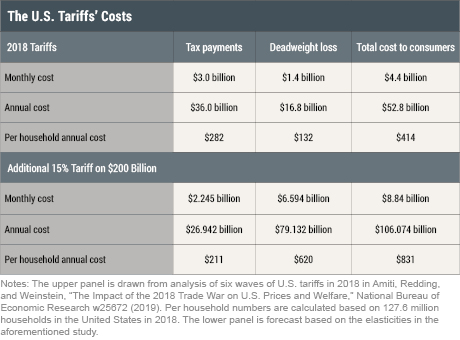Tariffs on $200 billion of U.S. imports from China subject to earlier 10 percent levies increased to 25 percent beginning May 10, 2019, after a breakdown in trade negotiations. In this post, we consider the cost of these higher tariffs to the typical U.S. household.
One way to estimate the effect of these higher tariffs is to draw on the recent experience of the 2018 U.S. tariffs. Our recent study found that the 2018 tariffs imposed an annual cost of $419 for the typical household. This cost comprises two components: the first, an added tax burden faced by consumers, and the second, a deadweight or efficiency loss.
The magnitude of these costs depends on how a tariff affects the prices charged by foreign exporters and the U.S. demand for imported goods. Studies, including our own, have found that the tariffs that the United States imposed in 2018 have had complete passthrough into domestic prices of imports, which means that Chinese exporters did not reduce their prices. Hence, U.S. domestic prices at the border have risen one‑for-one with the tariffs levied in that year. Our study also found that a 10 percent tariff reduced import demand by 43 percent.
U.S. purchasers of imports from China must now pay the import tax in addition to the base price. Thus, if a firm (or consumer) is importing goods for $100 a unit from China, a 10 percent tariff will cause the domestic price to rise to $110 per unit. This adds a $10 cost per unit for buyers of imports, but it is not a true cost for the U.S. economy because the money is simply transferred from buyers of imports to government coffers and thus could, in principle, be rebated.
Some firms may also reorganize their supply chains in order to purchase their products from other, cheaper sources. For example, the 10 percent tariffs on Chinese imports might cause some firms to switch their sourcing of products from a Chinese firm offering goods for $100 a unit to a less efficient Vietnamese firm offering the product for $109. In this case, the cost to the importer has risen by nine dollars, but there is no offsetting tariff revenue being paid to the government. This tariff-induced shift in supply chains is therefore called a deadweight or efficiency loss.
Economic theory tells us that deadweight losses tend to rise more than proportionally as tariffs rise because importers are induced to shift to ever more expensive sources of supply as the tariffs rise. Very high tariff rates can thereby cause tariff revenue to fall as buyers of imports stop purchasing imports from a targeted country and seek out imports from (less efficient) producers in other countries.
We can see these two forces at work when we compare the estimates of the costs of the 2018 tariffs with those of the recently announced higher tariffs on $200 billion of Chinese products. As one can see in the following table, in November 2018, purchasers of imports were paying $3 billion per month in added tax costs and experiencing another $1.4 billion in deadweight losses. Thus, the total bill for U.S. importers was $4.4 billion per month. If we annualize these numbers, they amount to a cost of $52.8 billion, or $414 per household. Of this cost, $282 per household per year was flowing into government coffers as a tax increase and could theoretically be rebated. For example, U.S. government transfers to farmers to mitigate their losses from foreign retaliatory tariffs can be thought of as households receiving just this type of transfer. However, deadweight losses accounted for an additional $132 to households per annum and represent a net loss to the U.S. economy that is in excess of any tariff revenue collected by the government.

Based on these estimates, we can infer the likely cost of increasing the tariff rate from 10 percent to 25 percent on $200 billion of Chinese imports. From the table, we see that the tax portion of the cost to households actually falls, from $282 to $211 per annum, because the tariff-inclusive price for Chinese imports becomes so high that consumers start to purchase substitute goods from countries like Vietnam instead. As the U.S. economy sources more goods from countries other than China, firms are forced to pay more for similar goods, but there is no tariff revenue collected. Our results are based on estimates where imports from China can be substituted for other foreign suppliers or stopped altogether. In principle, consumers could switch expenditure to domestically produced goods, where domestic firms might be able to benefit from the lack of foreign competition, but in practice, other studies have found that other developing countries often pick up much of the slack when one of them is targeted. Nevertheless, the deadweight efficiency loss arises regardless of whether consumers switch to more expensive foreign sources or to a more expensive domestic source.
As a result of this expenditure switching, we estimate that the annualized deadweight loss increases from $132 to $620 per household, bringing the total annual cost of the new round of tariffs to the typical household to $831. In sum, according to our estimates, these higher tariffs are likely to create large economic distortions and reduce U.S. tariff revenues.
Disclaimer
The views expressed in this post are those of the authors and do not necessarily reflect the position of the Federal Reserve Bank of New York or the Federal Reserve System. Any errors or omissions are the responsibility of the authors.
 Mary Amiti is an assistant vice president in the Federal Reserve Bank of New York’s Research and Statistics Group.
Mary Amiti is an assistant vice president in the Federal Reserve Bank of New York’s Research and Statistics Group.
Stephen J. Redding is the Harold T. Shapiro*64 Professor in Economics at Princeton University.
David E. Weinstein is the Carl S. Shoup Professor of the Japanese Economy at Columbia University.
How to cite this blog post:
Mary Amiti, Stephen J. Redding, and David E. Weinstein, “New China Tariffs Increase Costs to U.S. Households,” Federal Reserve Bank of New York Liberty Street Economics (blog), May 23, 2019, https://libertystreeteconomics.newyorkfed.org/2019/05/new-china-tariffs-increase-costs-to-us-households.html.











 RSS Feed
RSS Feed Follow Liberty Street Economics
Follow Liberty Street Economics
I find your article an excellent antidote to the simplistic notion that tariffs help the US economy. In response to Craig Nelson’s comment (June 7), besides the fact that the 9% was used for illustrative purposes, it is more than likely that there is price gap of at least 9% between China and other countries (could be a lot more depending on the product). The reason why China did not increase its prices is simply because “China” is not the exporter: Chinese companies are. And they are fiercely competitive against each other.
It seems unlikely that there is a 9% gap between the cost of imports from China and imports from everywhere else in the world. If that were true, why wouldn’t China have increased their prices by 5,6 or even 8% – may more money and still be cheaper? You also give no benefit to materials that were produced in China now being produced in the US.
I have two quick questions about this analysis. Let’s assume some of the tariffs are on industrial goods (as opposed to consumer goods). Does the tariff really get passed on to a ‘typical household’ in a one-to-one way? I have a hard time seeing how the full change in the cost of industrial goods would get passed on to me. Second, does the model account for goods that are imported, and then used for the production another good which is then exported? It seems to me, in that case, the additional cost would be passed on to whoever ends up with the final goods, not necessarily US households. Thoughts?
Well thought out but missing an important component – FX. Is it not reasonable to assume that we will see further weakening in the Yuan based on a slowing Chinese economy resulting in part because of the trade sanctions? Just looking at WSJ we have already seen some devaluation which reduced the impact – shouldn’t that play out further? Thanks, Justin
Why does you analysis totally ignore currency devaluation? Recent analysis indicates that the cost of Chinese imports actually decreased by 0.9% as a result of yuan devaluation.
NOTE: In addition to the reader comments posted here, we received an offline question that we wanted to answer publicly: Q. Are the costs in the table total costs or incremental costs? Are you saying that the new tariffs will cost the average household $831 per household per year in addition to the $414 per household per year cost that they were already paying? A. The $414 number in the upper panel of the table is the annualized total cost of all of the new tariffs imposed in 2018, e.g., including the steel tariffs, solar panels, washing machines, and all three tranches of the China-specific ones. The aggregate numbers come from our recent study [https://www.nber.org/papers/w25672.pdf]. To put these costs in perspective, in the blog post we divided the annualized monthly number by the number of households in 2018 reported by the Census (equal to 127.6 million as reported in the note to the table). The total cost number includes both the deadweight loss and the added tax payments to the U.S. government. Additional tax payments could, in principle, be rebated to households but the $133 per household deadweight loss is an efficiency loss that represents a real loss to the United States. The lower panel of the table uses the estimates from our paper to infer the total cost of the tariffs, taking account of the new 15% tariff on $200 billion of imports from China, which raised U.S. tariffs on these products from 10% to 25%. So the $831 total household cost is the total household cost of all tariffs that were raised in 2018 and this year.
In reply to tanstaafl: Thank you for your comment on our blog. While you are correct that our analysis is based on a partial equilibrium framework, another study [https://www.nber.org/papers/w25638] analyzed the costs of the 2018 tariffs for the United States in a general equilibrium framework and produced very similar numbers to ours. Thus, we do not think the choice of partial vs. general equilibrium analysis makes a large difference for the conclusions. In both of these studies, import demand is a function of domestic production, so the analysis does implicitly take tradeoffs between domestic and foreign production into account. As mentioned in the blog post, the efficiency loss arises whether U.S. purchasers switch to other foreign sources or domestic sources. We do, however, agree that we have not taken the costs of foreign retaliation into account in this analysis. These foreign tariffs may well be another source of loss for the United States.
This is a very unsatisfactory partial equilibrium analysis that is being spread in the mainstream press as gospel. A better general equilibrium analysis would factor in these impacts, among others: 1. Net gains in domestic income resulting from substitution from imported to domestically produced goods. 2. Net loss resulting from China’s retaliation.
what was the effect of the tariffs imposed prior to 2016 on the US economy?